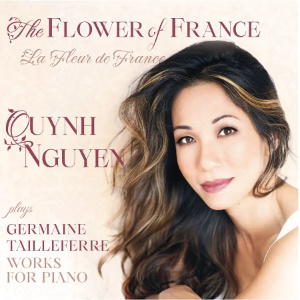
Germaine Tailleferre (1892-1983)
The Flower of France
Quynh Nguyen (piano)
rec. 2021/23, Oktaven audiO Studio, Mount Vernon, USA
Music & Arts MA-1306 [79]
I recently reviewed a twofer of music for two pianos by Reynaldo Hahn, Charles Koechlin and Germaine Tailleferre. Tailleferre studied with Koechlin and with Ravel, and Satie gave her much encouragement, before she became the only female member of Les Six. The character of her music evolved throughout her life, but she already had her own style when she was 20, long before Les Six.
Tailleferre’s style manifests itself in the first few works on this disc: the Impromptu, the Romance and Pas trop vite.(The latter and the somewhat later Sicilienne demonstrate her humorous side.) She was a mature and accomplished composer, and a fine pianist, when she wrote the children’s suite Fleurs de France (Flowers of France). The suite may seem simple, but it shows great imagination. Tailleferre gives imaginative descriptions of each of the eight flowers (see contents at the end of the review), and works in the atmosphere of the eight localities – all that in nine minutes. I especially liked the serene Anthémis [chamomile] du Roussillon, although Lavandin [lavender] de Haute-Provence is just as distinctive.
Jumping ahead chronologically, tracks 31-37 contain some of the composer’s best piano works. Let me leave the Larghetto and the Valse lente aside for a moment. The Partita for Piano, like Fleurs de France, compresses a great deal into a small span of time. After a stimulating Perpetuo mobile, the Notturno is the heart of the work, with all the emotional depth Tailleferre brought to her later works. The Allegretto looks back fondly at her teacher Ravel.
The music discussed so far was written for the concert hall. The works on the remainder of the disc originated in Tailleferrre’s operas, ballets and film scores. (She also wrote for radio and television.) French film studios were among the first to employ classical composers to wrote original scores for their films. Tailleferre started in 1929 with a documentary about the Incas. The selections here, Chiens (Dogs) and Pastorale Inca, more than merely descriptive, show a sense of the potential of film music rare among classical composers at that time. Another documentary film score was L’Aigle de rues (Street Hawk). Its scenario has unfortunately been lost, but one must admire Tailleferre’s handling of the opening material in the five sections here.
Tailleferre also wrote the music for the ballets Parisiana and Paris-Magie. The two excertps demonstrate her love of the capital city. The most impressive piece in this group is the Larghetto from the score for George Debecque’s only feature film, Coincidences. Tailleferre shows a depth of expression that makes one long for the entire score. One more film score, about the 19th-century Barbizon school of painting, intriguingly in a Baroque style, is a complete success.
Much of the programme has been recorded before, but rarely so well. Quynh Nguyen, who studied in Paris among other places, is familiar with the milieu of Tailleferre’s music, and she demonstrates affection and understanding for the music itself. She is especially good with the slower works. No nuance of the composer’s style escapes her in this sympathetic survey of fine music.
William Kreindler
Help us financially by purchasing from



Contents
1. Impromptu (1912)
2. Romance (1913)
3. Pas trop vite (1914)
4. Pastorale in D major (1919)
5. Hommage à Debussy (1920)
6. Très vite (1920)
7. Sicilienne (1928)
8. Pastorale in A-flat major (1928)
Fleurs de France: Children’s Suite (1930)
9. No 1 Jasmin de Provence
10. No 2 Coquelicot de Guyenne
11. No 3 Rose d’Anjou
12. No 4 Tournesol du Languedoc
13. No 5 Anthémis du Roussillon
14. No 6 Lavandin de Haute-Provence
15. No 7 Volubilis du Béarn
16. No 8 Bleuet de Picardie
17. Chiens (1930)
18. Pastorale Inca (1931)
19. Minuet in B-flat major (1931)
20. Berceuse (1936)
21. Au Pavillon d’Alsace (1937)
22. Fugue du parapluie (1950)
23. Chant chinois (1951)
L’Aigle des rues (1952)
24. No 1 Valse
25. No 2 Berceuse
26. No 3 La dispute
27. No 4 Fugue
28. No 5 Lent
29. Pas de deux (from ballet Parisiana) (1953)
30. Pastourelle (from ballet Parisiana) (1953)
31. Larghetto (1954)
32. Valse lente (1954)
Partita for piano (1957)
33. I Perpetuum mobile
34. II Notturno
35. III Allegramente
36. Sonata alla Scarlatti (1964)
37. Reverie (1964)
38. Barbizon (1972)
39. Escarpolète (1975)
40. Singeries (1975)

















